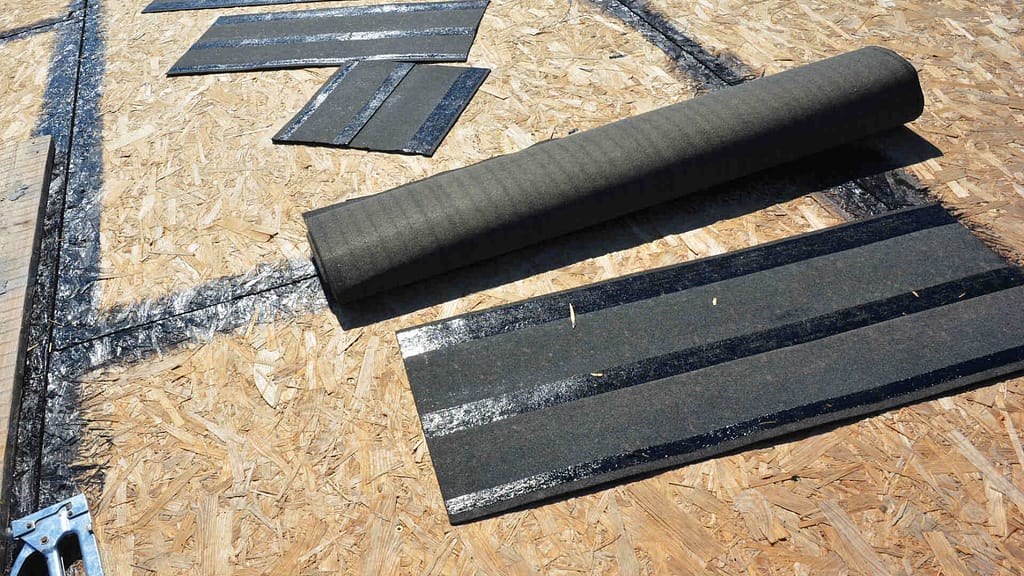Choosing the best roofing underlayment depends on several factors like weather conditions and your budget. Options include basic felt, durable synthetic, and waterproof rubber, each suited to meet specific needs effectively.
Table of contents
What is Roofing Underlayment?
Roofing underlayment is a layer of material placed between the roof deck and the shingles or outer roofing material. It acts as a protective barrier, helping to shield the roof from water damage and other environmental elements. This layer is crucial because it provides an extra level of protection against leaks that can occur due to wind-driven rain or as shingles wear over time.
The primary purpose of roofing underlayment is to keep the roof deck dry before the shingles are laid, and to protect the roof from moisture that might get past the shingles during their lifespan. It also provides additional benefits like improving roof deck stability, offering thermal resistance, and sometimes even enhancing fire resistance. Underlayment is essential for maintaining the integrity and longevity of the entire roofing system.
Types of Roofing Underlayment
There are several types of roofing underlayment available, each with its own set of characteristics, advantages, and limitations. Here’s a closer look at three common types.
Asphalt-Saturated Felt

Asphalt-saturated felt underlayment, often referred to as felt paper or tar paper, is made from natural fibers such as wood cellulose that are saturated with asphalt. This type of underlayment is popular due to its affordability and moderate level of water resistance. It provides a good basic barrier between the roof deck and the shingles above.
Potential drawbacks include its lesser durability compared to other more modern materials. It can tear easily if walked on and may degrade faster under extreme weather conditions, such as high heat or very cold temperatures
Synthetic Underlayment

Synthetic underlayment is made from polymers and polypropylene or polyester fabrics, offering stronger and more durable protection than traditional felt. It’s lighter, more tear-resistant, and often comes with features such as being waterproof or having UV protection. Many modern builders prefer synthetic underlayment because it’s easier to install and offers superior longevity and safety.
Potential drawbacks of synthetic underlayment include a higher cost compared to asphalt-saturated felt. Also, because it’s relatively slick compared to other materials, extra caution is needed during installation to prevent slips.
Rubberized Asphalt

Rubberized asphalt underlayment is a premium option that includes rubber polymers and asphalt, making it highly waterproof. This type is self-adhering, sticking directly to the roof deck, which eliminates gaps and makes for a very effective seal against water. It’s particularly useful in areas prone to high wind and rain.
Cost considerations for rubberized asphalt are significantly higher than for other types of underlayment, which might not make it the best choice for every budget. However, its exceptional waterproofing properties and durability make it an ideal choice for homes in areas with extreme weather conditions.
Best Underlayment for Different Scenarios
Choosing the right roofing underlayment depends on various factors, including the specific needs of the roof, the local climate, and budget constraints. Here’s a guide to selecting the best underlayment for different scenarios
Best Choices for High Wind Areas
In areas frequently subjected to high winds, a durable and strong underlayment is crucial to protect the roof from water that can be driven under shingles. Synthetic underlayment is often the best choice in these conditions. It is not only tear-resistant but also typically includes added features like enhanced grip to withstand the stress of high winds. Synthetic materials are also less likely to rip or come loose, providing a stable and secure layer beneath the shingles.
Top Picks for Budget-Conscious Projects
For those working with a tighter budget, asphalt-saturated felt offers a cost-effective solution without significantly compromising on quality. While it provides basic water resistance and is adequate for many mild climate areas, it is important to consider that it may not offer the longevity or the robust protection of more advanced materials.
Preferred Underlayment for Longevity and Durability
When longevity and durability are top priorities, rubberized asphalt underlayment is the preferred choice. Rubberized asphalt offers superior waterproofing and durability, ideal for severe weather, reducing long-term repair and replacement costs.
Consult a Professional Roofer for Tailored Advice
While the information provided in this blog offers a comprehensive overview of the different types of roofing underlayment and their suitability for various scenarios, it’s crucial to consult with a professional roofer for advice tailored to your specific needs. Roofing professionals have the expertise to assess the unique aspects of your home’s location, roof design, and local weather patterns. This personalized insight ensures that the underlayment chosen will offer optimal protection and performance for your particular situation.
A professional roofer can conduct a thorough inspection of your existing roof (if applicable) and consider factors such as the roof’s slope, the type of shingles being used, and the typical weather conditions in your area. They can also help navigate local building codes, which may dictate certain types of underlayment or installation methods. By seeking professional guidance, you can make an informed decision that balances cost, durability, and protection, ultimately ensuring that your roofing system remains robust and effective for years to come. For immediate assistance, visit our Find a Roofer Page to connect with a qualified professional today.
Conclusion
Choosing the right underlayment for your roof is very important. In this guide, we talked about different types of underlayment. Each type has its own benefits and fits different situations, like areas with strong winds or when you have a tight budget. Whether you choose the basic felt underlayment, the strong synthetic option, or the waterproof rubberized asphalt, knowing about each type helps you make a better choice for your home.
It’s always wise to consult with a professional roofer when selecting the best underlayment for your roof. Roofers have extensive knowledge about how different materials perform under various weather conditions and can advise on the best option for your specific needs. They ensure that your chosen underlayment is installed correctly, which is crucial for protecting your home, prolonging the lifespan of your roof, and maintaining safety.
Additionally, our roofing calculator is an excellent resource for estimating the amount of materials needed for your roofing project. Utilizing this tool can help streamline your planning process and ensure that you have all the necessary supplies for a successful installation.
Fact checked by Adrian Catolico – 6/4/2024

